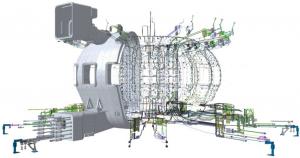Reviewing plans for in-vessel installation

The scope of in-vessel assembly includes tens of thousands of individual tasks. Diagnostic looms, loops, magnetic sensors, thermocouples, connectors, feedthroughs, waveguides, cables, and instrumentation; pipe-based pellet and gas injection systems; ELM and vertical stability in-vessel coils; blanket manifolds and blanket modules; diagnostic and heating port plugs; and divertor cassettes—all need to be installed within limited space constraints, according to an optimized sequence, and in good coordination with other engineering teams involved in coactivity.
Experience shows that precision and proficiency in executing assembly tasks is critical, particularly given the high volume of repetitive work. For example, approximately 1,000 sensors must be installed per vacuum vessel sector, while for the plasma chamber overall, 18 km of cables—housed in 99 looms—are supported by 9,000 clamps. The importance of commencing qualification well in advance of all processes and ensuring thorough training for operators was highlighted by review participants.
Other specific challenges such as the limited time available for the customization of components, limited clearance, and tight assembly tolerances are being addressed through comprehensive test and qualification programs and mockups.

Recognizing the essential role that metrology will play during the in-vessel assembly period, the review group mandated a fully developed metrology plan for the full in-vessel scope. A significant quantity of data must be processed for reverse engineering and the custom-machining of many system interfaces and supports in a short period of time. Additionally, participants emphasized the need to consider the intricate interaction between in-vessel and in-port works. Co-activity must be carefully considered, with the early anticipation of work interruption and robust protection measures to prevent possible component damage from subsequent activities.
In conclusion, the ITER in-vessel assembly represents a monumental engineering endeavour, requiring excellent preparation and planning, coordination, execution, and schedule and cost management. A comprehensive approach, addressing challenges and mitigating risks at every stage of the assembly process, will ensure the project's success.
